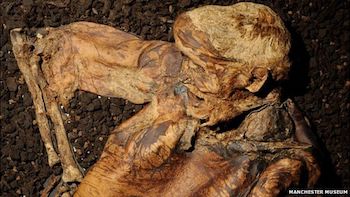5 Brutal Murderers Who Aaaalmost Got Away With It

There's no justice quite like swift justice, that drive-through satisfaction of seeing evil monsters get their just desserts piping hot. But sometimes, just like in the movies, we have to wait until the very, very end when it seems like all is lost and the bad guys have already jumped out of the plane to sweet freedom, only to find that Lady Justice packed their parachute with an anvil. We're talking about times like when ...
A Fake Buried Treasure Guilted A Maniac To Turn Himself In
Yamashita's Gold is a famous Filipino legend. It claims that during World War II, the dread Japanese general Tomoyuki "The Tiger" Yamashita buried his trove of stolen gold and jewels on an island but was executed for war crimes before he could return. And while many believe that they can find the vast riches, less scrupulous Filipinos figured out that the real riches are in scamming those dummies out of theirs.
In 2008, a bunch of crooks were doing just that as they claimed a dying general had given them a treasure map to Yamashita's Gold. Somehow, this obvious ruse ensnared an intensely religious Northern Irish dentist named Colin Howell who invested more than 350,000 pounds (roughly half a million dollars) into an expedition. An expedition that never went anywhere, as the Filipino "explorers" kept being thwarted by poison gas, bombs strapped to the gold, and whatever other Scooby-Doo booby trap they could make up to trap this boob in an endless cycle of payments.
Don't Miss
But before you start feeling sorry for ol' Howell, it might be important to note how he got all that adventuring money. See, Howell was the kind of devout Irish Catholic who cheated on his wife, Lesley. He was also the kind who, with the help of his mistress Hazel, then murdered both his wife Lesley and Hazel's husband Trevor Buchanan and framed it like a suicide pact. With no remorse, Howell collected his wife's insurance money so he could go play Pirates of the Caribbean on the other side of the globe. And he would've gotten away with it too if not for those Filipino scammers.
Amazingly, Howell had managed to stay frosty during the murders because he was convinced that God was totes cool with his murdering ways. But ever since his son suddenly died in a tragic accident in 2007, Howell, a massive narcissist, started doubting if the big man still had his back. So when, only a year later, he discovered he had been easily scammed out of all of his money, the religious nut became so convinced he was being punished by God, he went home and confessed to the murders. As if that wasn't enough, he then also admitted to having sexually assaulted many women while they were under sedation at his dental clinic. In 2011, he and his accomplice Hazel were sentenced to life in a maximum-security prison where the only buried treasure he'll find will be a dead rat in his porridge.
A Prehistoric Corpse Tricked A Killer Into Confessing To Murder
In 1959, Peter Reyn-Bardt and Malika Maria de Fernandez entered what he called a marriage of convenience. As a gay man, Peter could use Malika as a beard and she, in turn, could use him to get cheap airline tickets from his airport job -- a no-brainer win-win. But the marriage became less convenient when Malika decided to blackmail Peter for the crime of being gay in '60s Britain. So in June 1961, Peter decided to make the marriage convenient again by chopping up Malika with an ax and dumping her body in the nearby Lindow Moss bog.
When his wife went missing, the police immediately suspected Reyn-Bardt but had no evidence without the body. Eventually, they managed to imprison him on unrelated pedophilia charges (like he wasn't giving the British gay community enough of a bad name already), but even after he bragged about the murder to a cellmate, the charges didn't stick. And then Malika turned up. At least, that's what both the police and Reyn-Bardt thought. In 1983, over twenty years after the murder, two bystanders discovered the decomposed skull of a middle-aged woman in the peat bog. After forensics matched its age with that of Malika, Reyn-Bardt realized the jig was up and confessed in the face of overwhelming evidence, claiming, "It has been so long, I thought I would never be found out."
The murder was finally brought to trial, but in a surprise twist, an Oxford professor arrived to testify that they had not, in fact, found the remains of Malika but those of an ancient Brito-Roman woman. As it turns out, some peat bogs can create "bog bodies" where ancient corpses are preserved by the pickling powers of the peat so perfectly they look better than even the best-prepared mummies. So despite looking like spring cadaver, the remains were 1,700 years old which, doing some quick math, is slightly older than Malika Maria de Fernandez was. Reyn-Bardt tried to recant his confession, but it was too late. He was convicted of the murder of Malika and sentenced to a badly preserved life in prison.

The Key Witness Against Canada's Identity Killer Was A Rolex Watch
Canadians are so nice that, for a time, their most wanted criminal wasn't a murderer or a rapist or neo-Nazi but just some mini-Madoff who scammed 70 investors out of a few million dollars Canadian. But here's the twist: Canada's most wanted man was, in fact, a vicious murderer -- they just didn't know it yet.
Between 1990 and 1996, Albert Johnson Walker was living the con artist dream. The Canadian had managed to stash $3.2 million stolen dollars, kidnap one of his daughters, present her as his young wife, have two grand/regular daughters and start afresh in Harrogate, England. To launder his money, he began a business as a TV repairman with dual Canuck-British citizen Ronald Joseph Platt. Walker became fast friends with Platt, but not the "I'll drive you to the airport" friend, more the "I'll steal your identity and murder you" kind. He convinced Platt he'd pay for his return to the maple motherland in return for holding onto his British driver's license, birth certificate, and stamp -- for business purposes, of course. Ronald Platt set off to Canada, and Albert Walker changed his name to Ronald Platt and settled into his new fake, incestuous Brit life.
But after six years, the real Platt got sick of syrup and wanted to move back to Blighty. Walker had to find another way to guarantee he'd never set foot on British soil ever again, so he lured his Platt onto a boat off the coast of Devon, knocked him out, attached weights to his legs, and threw the still-breathing man overboard. Without skipping a beat, Walker resumed living life as Platt, knowing by the time fishermen found the waterlogged cadaver, it would be unrecognizable and deemed an unsolvable suicide. Walker's plan was waterproof. Unfortunately for him, so was Platt's Rolex.
Walker may have taken Platt's nationality, identity, and life but he had forgotten to take his watch, a very expensive and well-crafted Rolex, the only thing that survived the journey from watery grave to police evidence locker. The Rolex not only allowed investigators to determine the time of death with Swiss precision but also to trace its serial number back to its owner, Ronald Joseph Platt. Which was strange, since a man by that name was still walking around Harrogate with his young and facially similar wife.

Despite trying to pretend to be a completely different American man, one who implausibly said "eh" at the end of each sentence, Walker was finally found out. Not as easily conned, a British judge described the Canadian sociopath as "a plausible, intelligent and ruthless man who poses a serious threat to anyone who stands in your way" and sentenced him to life in prison. Afterward, having politely waited their turn, the Canadian government shipped Walker back home to give him another five years for the fraud on top of his life sentence, which is the kind of deal that only a ruthless scam artist like Walker could appreciate.
The Bullseye Killer Was Identified By Going On A Game Show
Lest you think British TV is all The Crown and Sherlock and competitive crumpet baking, it's had its share of low-effort junk. Like Bullseye, a game show that combined pub quiz trivia with the exciting world of professional darts and was somehow one of Britain's most popular shows for over 25 years. But before you think it's too naff, Bullseye did more to help catch actual muderers than Benedict Cumberbatch ever did.
John Cooper was a Welsh serial killer. In the '80s, he was the prime suspect of the murders of Richard and Helen Thomas and Peter and Gwenda Dixon. His M.O. for both was the same. Cooper would hold them up at gunpoint, rob them, and, no matter what, kill them anyway with a shotgun blast to the face at point-blank range. Unfortunately, Cooper was a clever psychopath who knew how to get rid of DNA evidence, even if it meant burning down an entire house. But the police managed to get their hands on an eyewitness, who gave a detailed description of ... the back of the perpetrator's head.
With very little to go on, the case went cold. But the police had time. Aside from being a murderer and arsonist, Cooper was also a thief, armed robber, and pedophile rapist, so the police were eventually able to throw him in jail for while they kept their fingers crossed for a break. The murders laid dormant for twenty years until a cold case unit finally solved it thanks to the greatest modern inventions: DNA testing and DVR taping.
The investigators found out that two months before the last killings, Cooper had competed on everyone's favorite darts-themed game show Bullseye with below-average accuracy. (What can you expect from a guy who used a sawn-off shotgun at a one-pace distance?) More DVD-savvy than their '80s counterparts, the investigators realized they could commandeer a tape and "freeze John Cooper in exactly the same position as the artist's impression" of his back, which, according to the lead investigator, turned out to be so similar it made the sketch look like a "tracing."
With the gruesomely compelling before-and-after images and some new DNA evidence, a jury was easily convinced that the mulleted monster in the courtroom was the same mulleted monster in the sketch which was the same mulleted monster winning a washing machine on the telly. Fresh out of prison for robbery, The Bullseye Killer was marched right back in for a life sentence.
A Double Jeopardy Fiasco Almost Allowed The Fort Bragg Slayer To Go Free
On March 11, 1986, police found the mutilated bodies of Katie Eastburn and two of her daughters, five-year-old Kara and three-year-old Erin, in their home at Fort Bragg. Erin had been beaten to death in the same room as her mom, while Kara had been stabbed through the Star Wars blanket under which she was hiding. Katie had been beaten, stabbed, and raped. All three had their throats slit for good measure. With that kind of carnage, it didn't take long for a court to find the monster who did it guilty. And then not guilty. And then guilty again.

Army Sergeant Timothy Hennis might as well have had "guilty" tattooed on his forehead. He had been to the Eastburn house days before to adopt their dog, and several neighborhood eyewitnesses saw a man with his exact description wearing a Members Only jacket and sneaking out of the house with a trash bag. Meanwhile, Hennis had tried to have his Members Only jacket dry cleaned, was seen burning a bunch of stuff in a barrel in his backyard, and, despite always being broke, was suddenly flush with cash (the Eastburns' credit card had been stolen). After all the witness statements and Hennis' impassive face when the bloody crime scene photos were presented, it took a jury roughly half a second to convict him of the murders and sentence him to death.
But Hennis had a great lawyer. After several appeals, North Carolina State Supreme Court ruled that the the jury had been unfairly influenced by having been shown the graphic pictures of the murders (i.e. evidence) and allowed a retrial. Meanwhile, Hennis maintained his innocence, even claiming he had received letters from "the real killer," a "Mr. X" thanking him for taking the rap. So with the prosecution having one hand tied behind their back and the defense going full O.J. by sowing as much doubt as possible, Hennis was once and for all found not guilty.

For seventeen years, Hennis walked around as a free man, even re-enlisting in the Army and retiring as a Master Sergeant. But during those years, DNA testing got a lot better, and in 2006 a cold case detective managed to match the semen in Katie's rape kit to Hennis' DNA. But despite the new slam dunk evidence, there was a tiny problem: Double jeopardy, the rule in the United States Constitution that says the same court can't judge the same guy for the same crime twice. So North Carolina couldn't put Hennis behind bars again.
But Hennis wasn't just a Carolina man, he was also an Army man, a federal institution with its own court system. So when the military found out that Hennis was about to walk free on a technicality, they recalled him to active duty for no other purpose than to drag his uniformed ass in front of a federal court-martial. There, a jury of his well-disciplined peers found, for the second time, that he was guilty as all hell and put him on death row, where Hennis remains to this day.
E. Reid Ross has a book called BIZARRE WORLD that's on store shelves as we speak. Or you could just order it now from Amazon or Barnes and Noble and leave a scathing/glowing review.
Abraham is a Mexican lawyer. When he isn't doing law stuff he writes comedy! You can say hi to him on Twitter here or follow him on Wattpad to read some of his upcoming fictional stories here.
Raoni would like to invite you to enjoy his good friend Munha da 7 's band: SATANIQUE SAMBA TRIO - The Original Pagothic
Follow Ryan Menezes on Twitter for bits cut from this article and other stuff no one should see.
Top image: Fer Gregory/Shutterstock